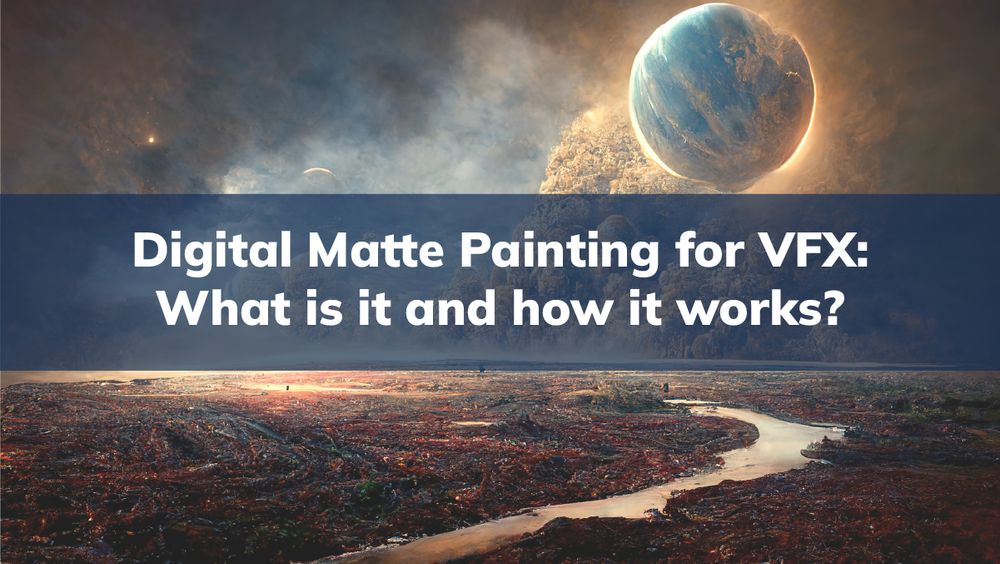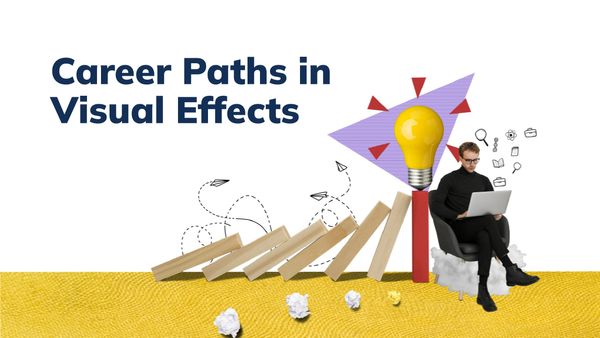Digital Matte Painting for VFX: What is it and how it works?
What is digital matte painting? Matte painting is a technique used in the film and television industry to create a painted or digital representation of a location, set, or scene that would otherwise be too expensive or impossible to produce physically. It involves creating a detailed, highly realistic image used as a background element in a shot, often to create the illusion of a larger or more elaborate environment. Matte painters use various techniques and tools to make compositions, including traditional painting, digital painting, and 3D modeling software. Using visual effects software, the finished matte painting is then composited into the live-action footage.
Matte paintings have been used in film and television for decades and are an essential part of the visual effects process. They are used to create everything from sweeping landscapes and alien planets to historical cities and futuristic megacities. The Digital matte painting VFX technique has evolved, with advances in digital technology allowing matte painters to create increasingly detailed and realistic images.
Despite these advances, matte painting remains an art form that requires a combination of technical skill and artistic talent. If you are one of those who wants to learn this, then opt for the most useful and thorough Certificate course in digital matte painting for VFX.
How Does Matte Painting Work?
A place, set, or scene can be easily represented by matte painting as a painted or digital image. It is constructing a realistic image that is extremely detailed and used as a background in a shot, frequently to give the impression of a larger or more intricate location.
There are several steps involved in the Digital matte painting VFX process:
1: Pre-production
Before starting work on the matte painting, the Digital matte painting VFX team will work with the production team to determine the look and feel of the final image. This may involve creating concept art or reference images to guide the painting process.
2: Planning
The matte painter will then plan out the composition of the matte painting, determining the placement of elements within the frame and the overall aesthetic of the image.
3: Sketching
The matte painter will then create a rough sketch of the matte painting using traditional drawing techniques or digital tools. This step helps to establish the basic structure and layout of the image.
4: Painting
Once the sketch is complete, the matte painter will create the final image. This may involve using traditional painting techniques, such as oils or acrylics, or digital tools, such as Photoshop or 3D modeling software.
5: Compositing
The finished matte painting is then composited into the live-action footage using visual effects software. This involves layering the matte painting over the live-action footage and adjusting the colours, lighting, and other elements to create a seamless integration.
Digital Matte painting is a complex and intensive process. Still, the result can be awe-inspiring, creating the illusion of expansive and detailed environments with ease.
The Digital Matte Paining Software knowledge is must for the painters or designers to have the freedom of working, offering best outcomes. It includes,
The Birth of Matte Painting
The use of matte paintings to create visual effects in film and television can be traced back to the early days of cinema. One of the earliest known examples of matte painting is the City of the Future sequence in the 1935 film Things to Come, directed by William Cameron Menzies. In this sequence, Menzies used a combination of live-action footage and matte paintings to create a futuristic cityscape.
The matte painting technique continued to evolve throughout the 20th century, with artists using increasingly sophisticated techniques and tools to create more detailed and realistic images.
In the 1960s and 1970s, advances in digital technology allowed matte painters to create matte paintings using computers and digital painting software rather than traditional paints and brushes. This revolutionized the matte painting process and allowed artists to create more complex and detailed images than ever before.
Today, matte painting remains an essential part of the visual effects process in film and television, with artists using a combination of traditional techniques and digital tools to create stunning and highly realistic images. The method has also been used in other areas, such as video games, commercials, and theme park attractions.

Digital Matte Painting Today
The basic principles Digital Matte painting have remained unchanged, the tools and techniques used by matte painters have evolved significantly over time. One of the most significant advances in matte painting in recent years has been the widespread adoption of digital tools and Matte paining software.
Many matte painters today use digital software, such as Digital Matte Painting Photoshop or Digital Matte Painting VFX to create their compositions. These programs allow artists to quickly and easily change their images, adjust colours and lighting, and add layers and details to their paintings.
Another trend in matte painting is using 3D modeling software to create more complex and realistic environments. This allows matte painters to create 3D models of buildings, landscapes, and other elements, which can then be used as the basis for their matte paintings.
Despite these advances, matte painting remains an art form that requires a combination of technical skill and artistic talent. Successful matte painters can combine these skills to create highly realistic and immersive environments that help to bring stories to life on screen.
In current times, Digital matte paintings were first used in the year 1985 for the film ‘Young Sherlock Holmes’. It was created by painter Chris Evans. He scanned a photogenic image and tried the method of layering it with the digital drawing for scene creation.
Chris Evans also did digital matte painting for the Star Wars film that includes the sequence of spaceship hanger in the most popular sequence of imperial march. Digital matte painting with VFX is now the new trend that is accepted and loved by all.
Great part to share is most of the enthusiasts are aware of the digital matte painting and that are choosing it as a career option. If you are one of those aspirants, then learn digital matte painting or choose an certificate course in digital matte painting with VFX for a rewarding career. There are some popular platforms who are offering job assistance if you choose an online digital matte painting course
What are the Benefits of Learning Matte Painting in VFX?
There are several benefits to learning matte painting as a visual effects (VFX) artist:
- Versatility: Matte painting is a versatile skill used in various projects and contexts, including film, television, video games, commercials, and theme park attractions. This means that learning matte painting can open up many career opportunities.
- Creativity: Matte painting allows VFX artists to use their imagination to create detailed and realistic environments that would be impossible to produce physically. This can be a rewarding and fulfilling aspect of the job.
- Demand: Matte painting is an essential part of the VFX process, and there is often high demand for talented matte painters. This can lead to job security and good career prospects for those with the necessary skills.
- Collaboration: Matte painting often involves working closely with other VFX artists and production team members, which can be a rewarding experience and help build professional relationships.
- Career advancement: Learning matte painting can help VFX artists to advance their careers by adding an essential skill to their resume. This can make them more valuable to employers and help them to stand out in a competitive industry.
How to start with Creative Digital Matte Painting and become a Matte Painter?
As you start learning a new disciple without any guidance it is quite tricky to know from where to get started with it. To make your journey of learning easy Digital matte painting VFX easier, ProAlley experts have create an innovative and enhanced course that makes you completed well aware of the concept and techniques used for Digital matte painting for VFX.
This course will give you in-depth understanding of matte painting. You will get acquainted with the essential perspectives to learn digital matte painting. You will learn to merge the camera angles of multiple players in a much logical and accurate ways. By learning the animation of 2D layers in a much dynamic pattern for creating realistic outputs will make your knowledge and techniques way to enhanced. It is a good idea to enrol for the Certificate course in digital matte painting for VFX to get started and land on your dream job.
How can I become matte painter?
To become a successful matte painter, you need to follow some advice that we have pulled from the experts:
- Don’t rush into designing process.
- Present your best work.
- Collect the reference data for your work (if any).
- Take the mentor advice and clear doubts.
- Brush up your skills by getting into an Online digital matte painting course.
- Use layers sensibly.
- Develop your communication skills.
Overall, learning digital matte painting can be a valuable investment for anyone interested in a career in VFX. There are wide range of Digital matte painting jobs that you can explore once you are certified. By opting for an Online digital matte painting course it can help open up a wide range of career opportunities and allow artists to use their creativity to bring stories to life on screen.



